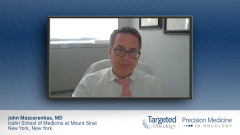
Goals of Therapy for Myelofibrosis
Experts in hematology-oncology share factors to consider when approaching the treatment of myelofibrosis.
Episodes in this series

John Mascarenhas, MD: The question I’m going to send back to you now is, when you see a patient and you’ve established the diagnosis, you have their molecular profile, their cytogenetics, and you’ve risk scored them, what’s the discussion with the patient about their expectations and their desires, and how are you going to help them achieve that with the therapies we have at hand?
Ruben Mesa, MD: It’s a good question. One, I share with them that the prognostic scores, because several of them have already learned about this and I’ve seen them quoted in the referring physicians’ notes, patients can become quite fixated on the numbers. So I share with them that these prognostic scores are helpful, and it’s probably true in other diseases as well, where we have prognostic scores in multiple hematologic malignancies. It does help separate subgroups of different biologies, of let’s say, low, intermediate, and high risk, regardless of the score you use. I think that part is helpful. I do think it makes the biggest impact regarding how we factor in the risk of transplant versus not going to transplant. What I do share with them is that I try to have patients not be too fixated on the survivals associated with each group. The lengths of survival of the patients used in many of these analyses certainly extend well into the past; many were in the pre-JAK inhibitor era, where people now live longer. I think they might underestimate the survival of current patients. I also share with them that they are averages, they are continuous.
A patient today was a 79-year-old gentleman. He was told he had high-risk disease with a survival of 3 years. He said he had to get his affairs in order because he was not going to see 2025 because that was 4 years from now. We try to walk that back for many reasons, not least of which is that for any 1 individual, we don’t know how accurate that’s going to be. Survival numbers are more helpful for populations than they are for individuals. I share with them that, as we think about the disease, it is both about the length of life and quality of life. I say that because we do sometimes have high-risk patients who feel pretty well, and we may have low-risk patients who don’t feel very well. If you have low-risk disease and you’re going to live a long time, but you feel miserable and are potentially medically disabled, which some are, that might be a very significant state that we want to change. On the flip side, there are individuals I’ve had who are at higher risk, are older, who prefer to be conservative because they’re feeling OK at the moment. I think both are very important factors to consider.
I start framing the conversation of the treatment into 3 buckets. Do we observe, do we treat with medicines, or do we go to transplant? For that first bucket, I think it’s a pretty discreet and shrinking bucket. There are subsets, who may be very young, maybe very low risk, who are found incidentally, who we observe. I think in myelofibrosis, in particular, that will be a vanishing subgroup given the progressive nature of the disease and other things. The vast majority of patients fall in the middle. What is appropriate medical therapy for them? What are our goals and the continual refinement of what that achieves? I share with them that our goal is to have the disease ideally be as neutral in their life as possible. This means we’re trying to prevent harm. We’re still mindful of preventing thrombosis and bleeding and trying to reverse symptoms, if they are present. We are trying to correct problematic cytopenias as well as splenomegaly, if it’s problematic. But also, we are trying to be mindful that the adverse effects or toxicity of a therapy don’t make it a bad bargain for them to be on. If I take a medicine because I have nights sweats, but instead it gives me crippling diarrhea, that isn’t a fair trade-off. We need to be mindful of both. The goal is to be neutral in terms of how they’re feeling and try to get them to the most comfortable state. Ideally, and we’ll talk about this later, we want to try to avoid disease progression, but in a way that they can tolerate. I view that the discussion of medicines is a separate discussion from transplantation.
Transplantation is a totally different animal. It’s a big all or none jumping off the cliff type of moment. Do you go for a potential cure, with both the impact in terms of health, duration to go through that process? Does that make sense for you? Are you comfortable with that? Is that something we do soon, in the next 6 months? Is that something we do if something changes, if you have progression, and we try to define something around that? Or is it something we’re just never going to do? The discussion with the 79-year-old I saw who had cardiac disease—that’s not something we’re ever going to pursue because it would be unlikely to be helpful. Those are some of the key ways I try to frame it. Again, I’m weaving in all of those different parts, my molecular testing, and other areas.
Transcript edited for clarity.







































